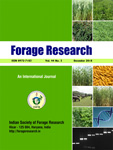SRAVANTHI G., DHEERAVATHU S. N., LATHA P., AVINASH S., JACOB J. AND VIJAYAKUMAR G.
Indian Institute of Millets Research, Hyderabad-500 030, (Telangana), India
Department of Crop Physiology, Agricultural College, Bapatla (ANGRAU) (Andhra Pradesh), India
Department of Crop Physiology, RARS, Tirupati, (Andhra Pradesh), India
*(e-mail: sevanayak2005@gmail.com)
(Received: 5 June 2025; Accepted: 27 June 2025)
SUMMARY
Heat stress is a significant abiotic factor that negatively impacts morphological, physiological, and growth-related yield traits in plants. seedling shoot length (SSL), root length (SRL), and root-to-shoot ratio (RSR) across 42 sorghum genotypes, consistent with established thermos-inhibition responses. Notable genotypic variation emerged, with hybrids CSH 16 and CSH 45, kharif variety CSV 27, and rabi varieties CSV 22 and M35-1 exhibiting superior shoot and root growth. Genotypes CSH 45, CSV 49, and AKMS 14A showed the highest RSR (1.04–1.12), suggesting adaptive root allocation under stress. Biomass analysis revealed CSH 41, AKR 150, and AKMS 14B as top performers in fresh weight (4.82 g), while CSV 17 and NR 10-15 led in dry weight (1.32 g). Strong correlations were observed between root and shoot traits (r = 0.68–0.91, p < 0.001), highlighting growth interdependence. Water content analysis identified CSH 48, CSV 27, and AKMS 14B maintaining high shoot (84.85%) and root (85.45%) water content, critical for moisture-scarce environments. Significant correlations between water content and biomass (r = 0.43–0.76) underscore the role of hydraulic efficiency in stress adaptation.
Key words: High-temperature stress, root toshoot ratio, total shoot water content, total root water content

